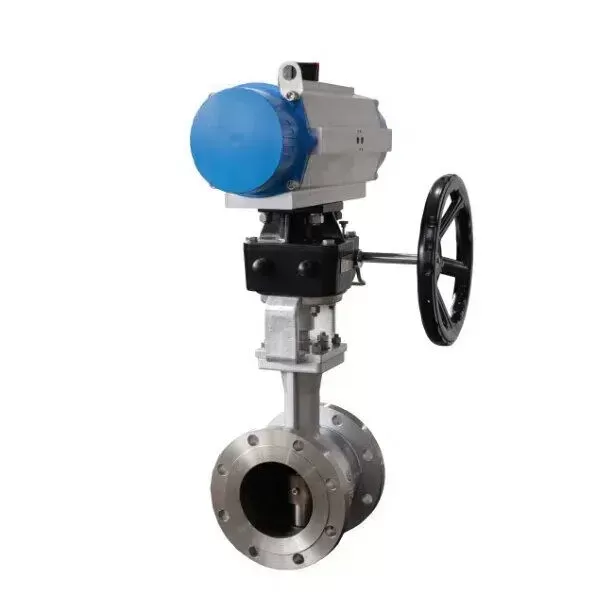Notifications

7 minutes, 25 seconds
-24 Views 0 Comments 0 Likes 0 Reviews

Understanding Eccentric Plug Valves: Operation, Flow Direction, and Industrial Applications
We are a leading control valve manufacturer in China, providing high-quality valves and control actuators designed to meet a wide range of industrial requirements.
Eccentric plug valves are a specialized type of rotary control valve designed for regulating fluid flow in demanding industrial environments. Characterized by an offset or "eccentric" plug, these valves rotate to control fluid passage, offering notable advantages over traditional plug valve designs. Their unique configuration results in improved sealing, reduced friction, and longer service life, making them ideal for handling abrasive, viscous, or otherwise challenging media.
Commonly used in industries such as mining, petroleum refining, power generation, and pulp and paper production, eccentric plug valves play a crucial role in ensuring efficient and reliable fluid control. One of the key aspects of their performance lies in the correct understanding and implementation of flow direction, which directly affects valve longevity, efficiency, and sealing performance.
Eccentric plug valves are rotary-type control valves that manage the flow of fluids by rotating an offset plug within the valve body. Unlike conventional plug valves, which have centrally aligned plugs, eccentric plug valves feature a plug mounted off-center. This design allows the plug to rotate in a cam-like motion, reducing direct contact with the valve seat during operation.
Constructed from durable materials such as stainless steel or specialized alloys, these valves are engineered to withstand harsh media, including slurries, coking fluids, and corrosive chemicals. Many designs include metal trim components to enhance wear resistance. Depending on the application, eccentric plug valves can be used for either throttling or on/off service and are typically available in flanged configurations for easy integration into pipelines.
The working principle of an eccentric plug valve is based on the motion of the offset plug. During valve operation:
Opening: As the valve opens, the eccentric plug pivots away from the seat in a cam-like motion. This minimizes friction and wear by avoiding direct scraping contact.
Flow Regulation: As the plug rotates, the flow passage opens gradually, allowing fluid to pass smoothly and with minimal resistance.
Closing: When closing, the plug gradually re-engages the seat, forming a tight and effective seal. The controlled motion reduces the chance of sudden pressure surges or damage.
This design results in smoother operation, better flow modulation, and longer service life compared to traditional valve types.
Correct flow direction is vital for achieving optimal valve performance. Eccentric plug valves are often marked with an arrow or label indicating the preferred flow direction. Installing the valve according to this specification is crucial for the following reasons:
The eccentric mechanism relies on a specific alignment between the plug and seat to ensure tight sealing. Installing the valve against the indicated flow direction can prevent the plug from seating correctly, leading to leakage.
When aligned correctly, the plug disengages smoothly from the seat, reducing wear. Incorrect installation forces the plug to move against the flow or seat inappropriately, accelerating internal wear and reducing valve life.
Correct orientation ensures a streamlined flow path with minimal turbulence or pressure drop. Misaligned flow can cause higher resistance, leading to energy loss and reduced system performance.
Improper installation of eccentric plug valves can lead to significant issues, including:
Increased Maintenance: Faster wear on seats and plugs can necessitate frequent servicing and part replacement.
System Inefficiency: Higher pressure drops and turbulent flow reduce operational efficiency and increase energy costs.
Leakage or Failure: Poor sealing due to misalignment can cause leaks or complete failure under pressure.
Thanks to their rugged construction and reliable sealing, eccentric plug valves are widely used across industries that require precision flow control under harsh conditions:
Mining and Slurry Handling: Efficiently controls abrasive slurries without clogging or erosion.
Petroleum Refining: Regulates flow of crude oil and refined products, even under extreme temperatures and pressures.
Power Generation: Manages the flow of steam, cooling water, and other high-pressure fluids.
Pulp and Paper: Controls caustic and fibrous media during pulping, bleaching, and chemical processes.
Food and Beverage: Suitable for controlling viscous liquids and syrups in sanitary processes.
Low Friction Operation: The offset plug reduces sliding contact, resulting in smoother operation and lower wear.
Precise Control: Offers excellent throttling capability for accurate flow regulation.
High Durability: Designed to endure erosive and corrosive fluids with minimal degradation.
Reduced Maintenance: Longer intervals between service due to wear-resistant design.
Broad Compatibility: Can be used in diverse industries and applications, handling a wide range of fluid types.
Eccentric plug valves are an efficient and reliable solution for controlling complex fluid flows in industrial systems. Their unique design minimizes wear, enhances sealing, and provides long-term value across a variety of applications. However, to fully benefit from their capabilities, correct installation—particularly with respect to flow direction—is essential. Ensuring proper alignment not only extends valve life but also maximizes system efficiency and safety. By understanding how eccentric plug valves work and applying best practices in installation and maintenance, industries can optimize performance and reduce operational costs over the long term.Know more about Google SEO Directory

